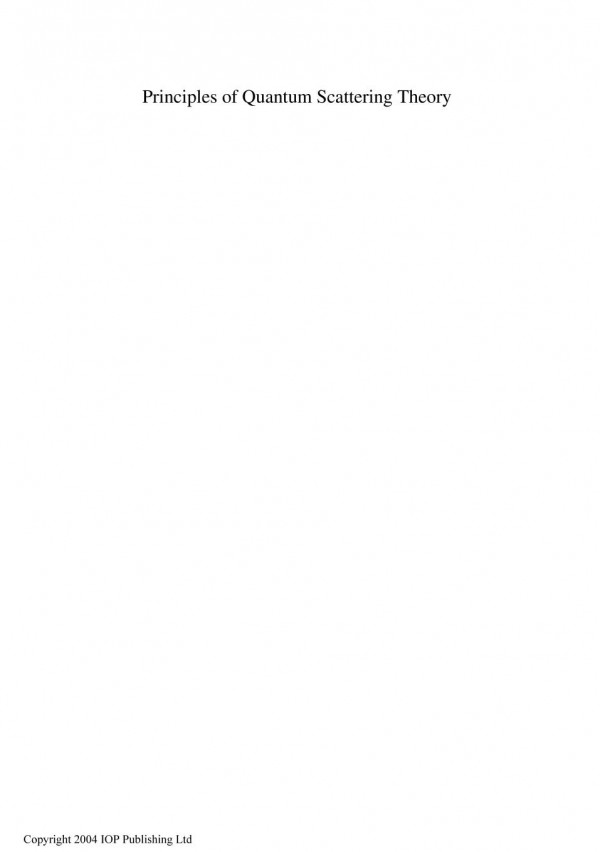

Most ebook files are in PDF format, so you can easily read them using various software such as Foxit Reader or directly on the Google Chrome browser.
Some ebook files are released by publishers in other formats such as .awz, .mobi, .epub, .fb2, etc. You may need to install specific software to read these formats on mobile/PC, such as Calibre.
Please read the tutorial at this link. https://ebooknice.com/page/post?id=faq
We offer FREE conversion to the popular formats you request; however, this may take some time. Therefore, right after payment, please email us, and we will try to provide the service as quickly as possible.
For some exceptional file formats or broken links (if any), please refrain from opening any disputes. Instead, email us first, and we will try to assist within a maximum of 6 hours.
EbookNice Team

Status:
Available0.0
0 reviews(Ebook) Principles of Quantum Scattering Theory 1st Edition by Dzevad Belkic - Ebook PDF Instant Download/Delivery: 9780367849115 ,0367849119
Full download (Ebook) Principles of Quantum Scattering Theory 1st Edition after payment
Product details:
ISBN 10: 0367849119
ISBN 13: 9780367849115
Author: Dzevad Belkic
(Ebook) Principles of Quantum Scattering Theory 1st Edition Table of contents:
PART I The selected main principles and the basic theoretical frameworks for a non-relativistic quantum-mechanical theory of scattering
A Introduction
B The main physical features of collision problems
B.1 Recognizable reference points of scattering theory
C Universality of the scattering problem
C.1 Fundamental aspects of collision theory
C.2 Collisions in various branches of physics
C.3 Importance of collisions in atomic and molecular physics
C.4 Collisions and new sources of energy
C.5 Application of collisional phenomena in other sciences
C.6 Application of collision phenomena in technology
1 The key features of quantum systems and the Kato conditions
2 Time evolution of quantum systems
3 The Schrödinger picture
4 The Heisenberg picture
5 The Dirac picture
6 The Dyson perturbation expansion of the evolution operator
7 Time-dependent scattering theory
8 Time-independent scattering theory
9 The problem of asymptotic convergence of scattering states
10 The principle of detailed balance
11 Convergence of series of operators, state vectors and matrix elements
12 Recapitulation of the selected main principles of quantum scattering theory
13 Summary to part I
PART II Selected applications of non-relativistic quantum scattering theory to energetic inelastic collisions of ions with atoms
14 The physics of double scatterings
15 The leading experimental methods for double scatterings
16 The two main theoretical frameworks for ion–atom collisions from low to high energies
17 Basic mechanisms behind elementary atomic processes
18 Direct momentum matching
19 Indirect momentum matching
20 Dynamic electron correlations
21 Thomas double scatterings of the active electron with two atomic nuclei
22 The impulse hypothesis
23 Drawbacks of the continuum distorted wave method and its ‘derivatives’
24 Coulomb–Born-type methods for electron detachment
25 A variational unification of low- and high-energy methods
26 Thomas-like dielectronic scatterings in transfer ionization
27 Projectile and target merged cold beams for highly correlated events
28 Thomas double scatterings of atoms in ion–molecule collisions
29 Collisions of cold ions and Bose–Einstein condensates
30 Fundamental reasons for the equivalence between the classical Thomas successive binary collisions and quantal double scatterings
31 Multiple ionization in fast ion–atom and ion–molecule collisions
32 Recapitulation on double scattering mechanisms
33 The reasons for the inadequacy of the standard impulse approximation
34 The reformulated impulse approximation (RIA)
35 An analytical calculation of the main scattering integral
36 Correlated electronic dynamics at all energies
37 Correct links between scattered waves and transition operator potentials
38 Illustrations
38.1 Computational methods
38.1.1 Deterministic methods
38.1.2 Stochastic methods
38.2 Atomic collision problems
39 Summary to part II
40 Outlook
References
People also search for (Ebook) Principles of Quantum Scattering Theory 1st Edition:
x-ray scattering theory
3 principles of quantum mechanics
what are the three principles of quantum mechanics
3 principles of science
4 principles of quantum mechanics
Tags: Dzevad Belkic, Quantum Scattering Theory